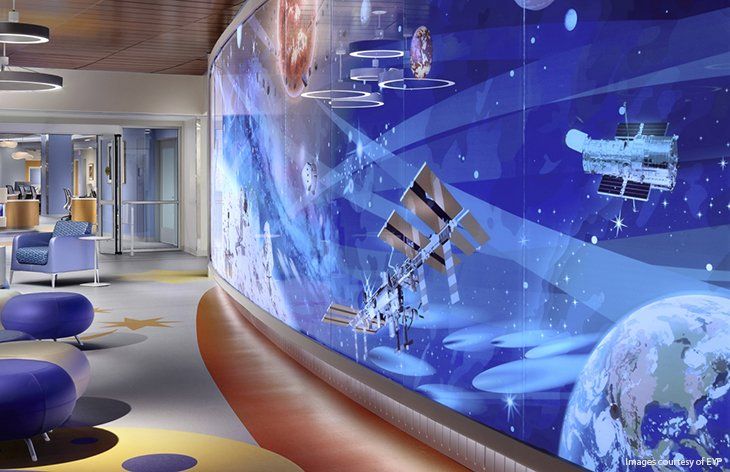Better Design to Help Ease a Parent’s Worst Nightmare
Simple design considerations at St. Jude Children's Research Hospital make a positive impact on loved ones.

When a child is injured, sick, or diagnosed with a severe health condition, it is an extraordinarily stressful situation for parents and families. Many times, the hospital environment can exacerbate that stress level. Poor lighting, confusing signage, unwelcoming spaces, and austere hospital rooms are just a few of the physical factors that increase anxiety and make patients––and their caregivers––question the quality of care they receive. Simple design considerations can make a massive difference in the lives of parents and guardians and improve clinical outcomes for patients. When we designed St. Jude Children's Research Hospital, a key consideration was incorporating as many anxiety-easing features as possible.
The average length of stay for hospital patients in the U.S. is about 4.6 days but for children at St. Jude’s, that stay is often longer due to the severity of the patients they treat. As a result, it's essential to create hospital rooms that aren't cold or clinical while paying careful attention to amenities.
At St. Jude's, the design team and hospital staff collaborated to determine how to conceal the clinical apparatus while keeping necessary equipment accessible. Room design helped remove daily reminders for patients and caregivers, while making the overall space and furnishings seem as home-like as possible. During the design research phase, parents provided feedback that they always wanted to be close to their child, and ideally never leave their side. As a result, the design team created adjacent family rooms to each patient room with large viewing windows into the patient room, but that also allow for privacy and refuge. These patient-family rooms helped parents stay closer to their children and reduce their stress. Each room also has a built-in desk with storage, wardrobes, and a closet for clothing and luggage storage, a separate bathroom with upgraded fixtures, and in places where space allows, double sleeper sofa beds. As mobile devices have become more prevalent, the design integrated USB ports into furniture and increased the number of electrical outlets in both the patient and adjacent family room.
The design brings natural light into each patient room. Studies show that natural light has a positive impact on the healing process, reduces stress, and helps patients and caregivers keep normal circadian rhythms. At the same time, the design took into consideration having appropriate window coverings for patients experiencing photophobia.
Related: CAR T Therapy Available to Medicare Beneficiaries
Because it is a hospital that cares for some of the most severe and critical cancer patients, the team incorporated extreme infection control measures into every aspect of the design. The design used specially treated fabrics, smooth surfaces where germs can't hide, anti-microbial materials, furnishings that are easy to clean, and light fixtures that don't attract dust. Since it is a place for children, special consideration to safety was also given by rounding corners, and softening edges to reduce "bonks" and other minor accidents.
Being a patient in a hospital is scary, but it is even more so for children who might not comprehend what is going on. Working closely with the St. Jude's team, the design team infused Disney-like magic and surprises throughout the hospital. Each of the three floors has a different theme and color palette. The first floor takes on an 'Under the Sea' theme featuring a palette of teals, blues, and purples. The second floor is 'Nature's Orchestra' representing everything on land in greens, yellows, and oranges. The top floor is 'Journey to Space' that employs jewel tones of purples and vibrant blues.
St. Jude also has a first-of-its-kind immersion room that allows patients to go on adventures. For example, the room integrates video that gives children the experience of flying like a bird through the forest, as well as other fun experiences. The immersion room also offers space to play video games and participate in video chats with loved ones. Other play spaces at St. Jude's let the patients make art and music. These spaces were designed explicitly as necessary diversions for young patients.
No parent wants their child to be ill or spend time in a hospital. However, when they seek care, a better design can make the experience less stressful and help contribute to better health outcomes. With a greater focus on the benefits of good design, patients and their caregivers can get through a difficult situation more quickly and with less stress.
Robin Kirkman, is senior interior designer, EYP Architecture & Engineering.
Chief Pharmacy Officer Jason R. Smith on the Challenges Health Systems Face
May 28th 2025Jason R. Smith, Pharm.D., appointed as chief pharmacy officer in February 2025 for the University of Rochester Medical Center, talks about building a stronger workforce, managing drug shortages and keeping up with changes in regulations because of the new administration.
Read More
Doing More and Saving More with Primary in Home Care
September 1st 2021In this week’s episode of Tuning In to the C-Suite podcast, MHE Associate Editor Briana Contreras interviewed VillageMD’s Senior Medical Director of Village Medical at Home, Dr. Tom Cornwell. Dr. Cornwell discussed the main benefits of primary care at home, which includes the benefit of cost savings for patients, maintaining control of hospital readmissions and others. Dr. Cornwell also noted what has changed in the industry of at-home care and if there has been interest from payers like insurance companies and medicare in the service.
Listen